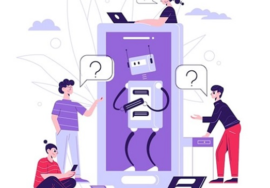
Speaking Robot: Brings Vision and Language to Life!
“Discover the Speaking Robot, a groundbreaking technology that brings vision and language to life. Experience the future today!”
Google’s unique vision-language-action paradigm, RT-2, helps robots comprehend and execute tasks more effectively in both known and unknown environments.
For decades, when people imagined the far future, they virtually always included robots in prominent roles. Robot speaker have been portrayed as trustworthy, helpful, and even charming.
Despite this, technology has remained elusive for decades, trapped in the domain of science fiction.
Today, they are unveiling a breakthrough robotics advancement that moves us one step closer to a future of helpful robots. The Robotics Transformer 2, or RT-2, is a vision-language-action (VLA) model that is the first of its kind.
RT-2 is a Transformer-based model that can directly produce robotic motions after being trained on text and images from the web. RT-2 transfers information from web data to inform robot behavior in the same way that language models are trained.
Robot language translator on text from the web to understand general ideas and concepts. In other words, RT-2 can communicate with other robots.
The real-world challenges of robot learning
The search of helpful robots has always been a monumental effort, because a robot capable of performing common activities in the world must also be capable of performing complicated, abstract tasks in highly unpredictable situations — particularly ones it has never seen before.
Robots, unlike robot Bluetooth speaker, require “grounding” in the actual world and their abilities.
Their education isn’t limited to learning everything there is to know about an apple, such as how it grows, its physical properties, or that one allegedly landed on Sir Isaac Newton’s head.
A robot must be able to recognize an apple in context, distinguish it from a red ball, comprehend its appearance, and, most importantly, know how to pick it up.
Historically, this has necessitated training robots on billions of data points firsthand, across every single object, setting, task, and circumstance in the physical world – a proposition so time consuming and costly that it has become innovators impracticable.
Learning is a difficult task for humans, and it is considerably more difficult for robots.
A new approach with RT-2
Recent research has enhanced robot reasoning, even allowing them to apply chain-of-thought prompting, a method for dissecting multi-step problems.
The emergence of vision models such as PaLM-E aided robots in better understanding their surroundings. RT-1 also demonstrated
that Transformers, famed for their ability to generalize information across systems, might assist different types of robots in learning from one another.
However, up until now, robots were controlled by intricate networks of interconnected systems, wherein low-level manipulation systems and high-level thinking systems played a rough version of telephone to move the robot.
Imagine having to instruct your body what to do to have it move once you have decided what you want to do.
With RT-2, all that complexity is eliminated, allowing a single model to output robot behaviors in addition to carrying out the intricate reasoning seen in foundation models.
Most crucially, it demonstrates that the system can transfer concepts encoded in its AI language and deep vision AI training data to control robot actions with a tiny quantity of robot training data, even for tasks for which it has never been trained.
For instance, you would have to specifically teach older systems to recognize trash, pick it up, and dispose of it if you wanted them to be able to discard a piece of it.
Because RT-2 can transfer information from a vast corpus of web data, it can recognize trash without explicit training because it already has a notion of what waste is.
Although it has never been instructed to do so, it even knows how to dispose of the waste.
Additionally, consider the abstract character of trash: after being eaten, items like a bag of chips or a banana peel turn into rubbish. Thanks to its vision-language training data, RT-2 can interpret that and perform the task.
A brighter future for robotics
A talking robot interview offers hope for a better future for robotics. Robots may be able to adapt to new circumstances and surroundings more quickly if they can use RT-2’s ability to translate information into actions.
The researchers discovered that RT-2 performed just as well as our prior model, RT-1, on tasks in its training data, or “seen” tasks, after evaluating RT-2 models through more than 6,000 robotic trials.
Furthermore, it nearly doubled its performance on new, untested cases, going from 32% on RT-1 to 62%.
Put differently, Robots can now learn English more like humans and their talking robot friends do by applying what they have learned to novel situations and training language models to follow instructions with human feedback, thanks to RT-2.
What is robot vision, and how does it operate?
Robot vision is the general term for the application of camera gear and computer algorithms to enable robots to analyze visual data from the environment.
For instance, your system might contain a 2D camera that identifies an object for the robot to pick up.
Why is robotic vision necessary, and what does it mean?
Robotic vision Robotic vision has developed significantly over the years, reaching a degree of sophistication with applications in difficult and complex activities like autonomous driving and object manipulation.
Nevertheless, it still has trouble locating specific objects in congested environments when some items are partially or entirely masked by others.
In addition to demonstrating how quickly developments in AI are trickling down to robotics, RT-2 holds great potential for more versatile robots.
30+ free AI tools that help you write creative, original content more quickly and affordably, and end writers who produce high-quality material instantly for all your copywriting requirements. You may quickly streamline processes and increase social media efficiency.
Discover how to use automation and intelligence to complete tasks.
Source: Google Blog Google Blog
Images credit: Freepik












